
VOL. I NO. 5 DELHI, THURSDAY OCTOBER 15, 1942.

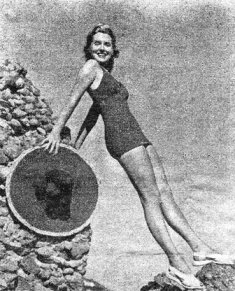 LOOK WHAT'S HAPPENING AT HOME - The caption we got said something about this being Brenda Joyce, 26, Excelsior
Springs, Miss., and being a typical American girl. Who cares about that? We wanna go home and just SEE for ourselves.
LOOK WHAT'S HAPPENING AT HOME - The caption we got said something about this being Brenda Joyce, 26, Excelsior
Springs, Miss., and being a typical American girl. Who cares about that? We wanna go home and just SEE for ourselves.
|
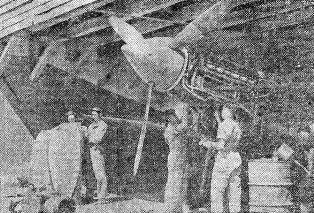 CHECKING A P-40 in a China air field hangar are members of a pursuit group of the China Air Task Force. Corp. J. B.
Woodville, Corp. R. W. Briansky, Corp. C. E. Lehman and Sgt. C. E. Hoffman are the gents who keep the fighters in the
air to the distress of the Jap.
CHECKING A P-40 in a China air field hangar are members of a pursuit group of the China Air Task Force. Corp. J. B.
Woodville, Corp. R. W. Briansky, Corp. C. E. Lehman and Sgt. C. E. Hoffman are the gents who keep the fighters in the
air to the distress of the Jap.
|
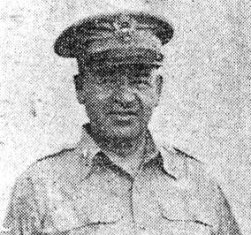
|
|
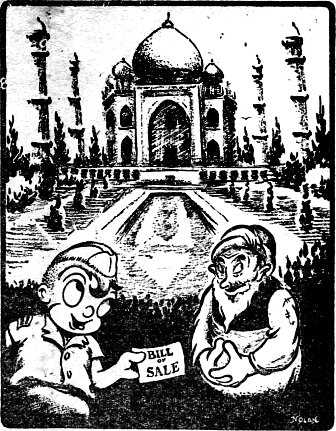
|
 OVERHAUL PLANT - Here are some of the fellows who have a mighty important part in keeping our planes flying in the
C.B.I. Theater. The scene is in the Airplane Engine Overhaul plant at an air depot which the U.S. Army Air Corps is
now operating in India.
OVERHAUL PLANT - Here are some of the fellows who have a mighty important part in keeping our planes flying in the
C.B.I. Theater. The scene is in the Airplane Engine Overhaul plant at an air depot which the U.S. Army Air Corps is
now operating in India.
|
 DISASSEMBLY - after the motors have been taken out of planes they move to the engine disassembly. Here, Corp.
Frank J. Anceleski, Pvts. Francis Leland and Donald C. Allen apply their wrenches.
DISASSEMBLY - after the motors have been taken out of planes they move to the engine disassembly. Here, Corp.
Frank J. Anceleski, Pvts. Francis Leland and Donald C. Allen apply their wrenches.
|
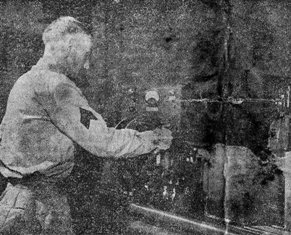 INSPECTION - Sgt. W. Crow operates a machine that tests for cracks or metal fatigue. Each part gets careful attention
with this device that can pick out flaws too small or concealed to be seen by the eye.
INSPECTION - Sgt. W. Crow operates a machine that tests for cracks or metal fatigue. Each part gets careful attention
with this device that can pick out flaws too small or concealed to be seen by the eye.
|
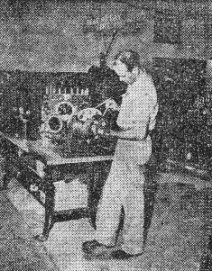 BEARING BAY - The work of "milking" the main crankshaft to fit a bearing is done by Sgt. William D. Massey.
BEARING BAY - The work of "milking" the main crankshaft to fit a bearing is done by Sgt. William D. Massey.
|
 CONTROL ROOM - After an engine has been overhauled, it is completely tested before it leaves the depot. Sgt. Granville
G. Russell mans the control room for this test. Through the window ahead, he can watch the engine perform.
CONTROL ROOM - After an engine has been overhauled, it is completely tested before it leaves the depot. Sgt. Granville
G. Russell mans the control room for this test. Through the window ahead, he can watch the engine perform.
|
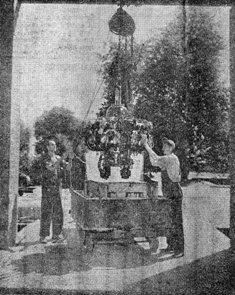 FINISHED PRODUCT - Fully tested and "pickled" - an oil spray that prevents corrosion - an engine is lowered into a
shipping crate by Sgt. James G. Wallace and Pvt. William B. Miner.
FINISHED PRODUCT - Fully tested and "pickled" - an oil spray that prevents corrosion - an engine is lowered into a
shipping crate by Sgt. James G. Wallace and Pvt. William B. Miner.
|
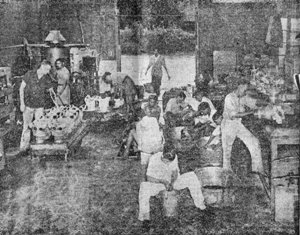 CLEANING - Many Indians are employed at this depot. In some cases, interpreters are necessary. Sgt. William C. Gafford
(left) inspects engine cleaning done by Indian workers.
CLEANING - Many Indians are employed at this depot. In some cases, interpreters are necessary. Sgt. William C. Gafford
(left) inspects engine cleaning done by Indian workers.
|
 PROMOTION - First Roundup promotion came from an Indian seaport where Pvt. John Cox bugles it out about the
Roundup and Yank clutched beneath his arm. Get that coat pressed, pal.
PROMOTION - First Roundup promotion came from an Indian seaport where Pvt. John Cox bugles it out about the
Roundup and Yank clutched beneath his arm. Get that coat pressed, pal.
|
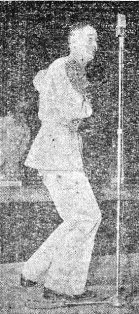
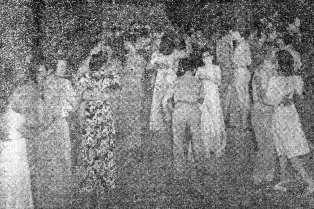 AMERICAN TROOPS threw a party for British paratroops in New Delhi a while back. Warrant Officer Harry Parnell of
the paratroopers wowed them with his version of "Frankie and Johnnie."
AMERICAN TROOPS threw a party for British paratroops in New Delhi a while back. Warrant Officer Harry Parnell of
the paratroopers wowed them with his version of "Frankie and Johnnie."
|
 CHRISTMAS PACKAGES FOR HOME - Here are your Christmas packages being loaded on that old transport at an Indian port.
Will the recipients or will they not pay import duty?
CHRISTMAS PACKAGES FOR HOME - Here are your Christmas packages being loaded on that old transport at an Indian port.
Will the recipients or will they not pay import duty?
|
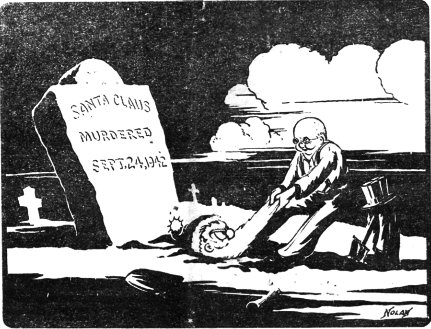 Hold everything, boys, a bill has now been introduced in Congress exempting all overseas troops from import duty
on articles valued at not more than $50. Above is artist Nolan's conception of Congress trying to revive Santa Claus.
Hold everything, boys, a bill has now been introduced in Congress exempting all overseas troops from import duty
on articles valued at not more than $50. Above is artist Nolan's conception of Congress trying to revive Santa Claus.
|
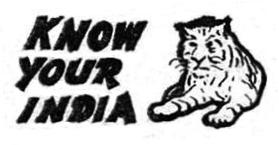
|
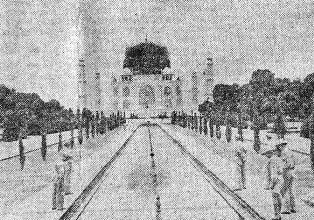 AHHH!!! THE TAJ - India's world-famous Taj Mahal and its beautiful surroundings hold the interest of these U.S. Army
men. Naturally, it's the top sightseeing attraction for all C.B.I. members in the vicinity.
AHHH!!! THE TAJ - India's world-famous Taj Mahal and its beautiful surroundings hold the interest of these U.S. Army
men. Naturally, it's the top sightseeing attraction for all C.B.I. members in the vicinity.
|
